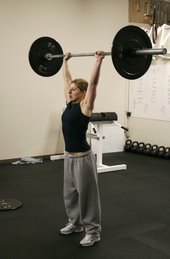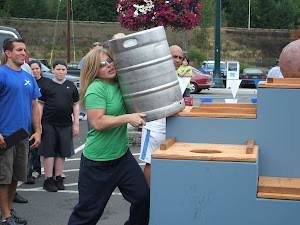In 'Buffy the Vampire Slayer' - and when it comes to vampires that's my most reliable source - a Vampire can't cross the threshold unless he's invited in. A seemingly simple way to avoid calamity would be an uncharacteristic lack of hospitality. That, I assume, would be far easier for me, a New Englander, than your average Northwesterner. But I'd venture that even the chronically polite could muster a bit of rudeness in order to avoid life sucking evil. Every day though, we all make simple nutritional mistakes that invite life sucking evil into our worlds. OK, maybe refined sugar isn't necessarily 'evil' but at the same time it has the capacity to suck energy and shorten lives.
In the case of vampires it would be easy to laugh at the justifications, "Maybe this is one of those nice vampires," "I'm sure I can take this one," or "he doesn't look hungry." With cookies or your garden-variety baked good, I hear equally comical, "I keep it in case I have guests," "sometimes I just want a little something," or "there not for me." These are the reasons I hear from clients when I'm talking about how a bag of cookies ended up 'dinner.'
Dracula had an aura; so do the cookies. Beyond the obvious chemical pulls, you have an entire marketing machine drawing you in and you don't stand a chance once they've crossed the threshold. Nice try, though.
Brian Wansink - he's one of those nice vampires - is the director of the Cornell University Food and Brand Laboratory and, as he explained in an interview with Lynne Rossetto Kasper of 'The Splendid Table' on NPR, the lab runs a restaurant in which scientists constantly study people's eating habits and preferences. His new book is Mindless Eating: Why We Eat More Than We Think and I'm sure that no food company has taken advantage of any of his findings.
Knowing that manufacturer's are putting their best research into making you eat more should make you more savvy about sidestepping strategies. Your 'wooden stake' is to measure, measure, measure and read labels. The following study, 'Why visual cues of portion size may influence intake' explains it very simply:
"Using self-refilling soup bowls, this study examines whether visual cues related to portion size can influence intake volume without altering either estimated intake or satiation. Research Methods and Procedures: Fifty-four participants (Body Mass Index of 17.3-36.0 kg/m2; aged 18-46) were recruited to participate in a study involving soup. The experiment was a between subject design with two visibility levels: 1) an accurate visual cue of a food portion (normal bowl) versus 2) a biased visual cue (self-refilling bowl). The soup apparatus was housed in a modified restaurant-style table in which two of four bowls slowly and imperceptibly refilled as their contents were consumed. Outcomes included intake volume, intake estimation, consumption monitoring, and satiety."
"Results: Participants who were unknowingly eating from self-refilling bowls ate more soup (14.7 ± 8.4 vs. 8.5 ± 6.1 oz; F1, 52=8.99; p<.01) than those eating from normal soup bowls. Yet despite consuming 73% more, they did not believe they had consumed more, nor did they perceive themselves as more sated than those eating from normal bowls. This was unaffected by BMI."
"Conclusion: These findings are consistent with the notion that the amount of food on a plate or bowl increases intake because if influences consumption norms and expectations and if it lessens one’s reliance on self-monitoring. It appears that people use their eyes to count calories and not their stomachs. The importance of having salient, accurate visual cues can play an important role in the prevention of unintentional overeating."
Beyond the obvious decision never to eat out of self-refilling bowls, it should be clear that 'eye-balling' isn't a reliable option. It turns out, it's not even a reliable option when the food is less than palatable. In the following study, BAD POPCORN IN BIG BUCKETS: PORTION SIZE CAN INFLUENCE INTAKE AS MUCH AS TASTE, serving size dictated consumption even when movie-goers were fed stale food:
"Objective: It is often believed that people overeat the foods they like. We investigate whether environmental cues such as packaging and container size are so powerful that they can increase our intake of foods that are less palatable. If so, there are be important implications for improving the consumption of healthy (but less preferred) foods. Design, Setting, and Participants: In a 2x2 between-subjects design, 158 Philadelphia moviegoers (57.6% male; 28.7 years) were randomly given a medium (120 grams) or a large (240 grams) container of free popcorn that was either fresh or stale (14 days old). Following the movie, consumption measures were taken along with measures of perceived taste."
"Outcome Measures and Results: Moviegoers who were given fresh popcorn ate 45.3% more popcorn when it was given to them in large containers. This container-size influence is so powerful that when the popcorn was disliked (in the case of the stale, 14 day old popcorn), people still ate 33.6% more popcorn when eating from a large container than a medium-size container."
"Conclusions and Implications: Even when foods are not palatable, these results caution that large packages and containers can lead to overeating. A silver lining of these findings may be that portion size can also be used to increase the consumption of less than- favorable healthy foods, such as raw vegetables."
Combating these tendencies takes both measuring and mindfulness. Ask yourself if inviting temptation into your world is really worth all the work of avoiding these foods once they're in your home (or your hands). Make sure everything you choose nutritionally supports your end-goal and be honest with yourself. Avoid situations in which you claim you'll just nibble or sample foods that are off your list for now since it seldom works out that way.
skip to main |
skip to sidebar








A conversation with my clients about exercises, work-outs and nutrition
Search This Blog

About Me
- Heather
- I'm an NSCA-PT and CrossFit certified personal trainer with nine years experience. I hold a purple belt in Brazilian Jiu Jitsu under Marcelo Alonso and Ben Blackstone and I am a Karnataka State Gold Medalist in Weightlifting.

Books
Brain Rules: 12 Principles for Surviving and Thriving at Work, Home, and School Food Politics: How the Food Industry Influences Nutrition, and Health, Revised and Expanded Edition (California Studies in Food and Culture)
Food Politics: How the Food Industry Influences Nutrition, and Health, Revised and Expanded Edition (California Studies in Food and Culture) Good Calories, Bad Calories: Fats, Carbs, and the Controversial Science of Diet and Health (Vintage)
Good Calories, Bad Calories: Fats, Carbs, and the Controversial Science of Diet and Health (Vintage) The Omnivore's Dilemma: A Natural History of Four Meals
The Omnivore's Dilemma: A Natural History of Four Meals Practical Programming for Strength Training
Practical Programming for Strength Training PROTEIN POWER
PROTEIN POWER Secrets of the Soil : New Solutions for Restoring Our Planet
Secrets of the Soil : New Solutions for Restoring Our Planet Starting Strength (2nd edition)
Starting Strength (2nd edition) The Brain Trust Program: A Scientifically Based Three-Part Plan to Improve Memory, Elevate Mood, Enhance Attention, Alleviate Migraine and Menopausal Symptoms, and Boost Mental Energy
The Brain Trust Program: A Scientifically Based Three-Part Plan to Improve Memory, Elevate Mood, Enhance Attention, Alleviate Migraine and Menopausal Symptoms, and Boost Mental Energy Fiber Menace: The Truth About the Leading Role of Fiber in Diet Failure, Constipation, Hemorrhoids, Irritable Bowel Syndrome, Ulcerative Colitis, Crohn's Disease, and Colon Cancer
Fiber Menace: The Truth About the Leading Role of Fiber in Diet Failure, Constipation, Hemorrhoids, Irritable Bowel Syndrome, Ulcerative Colitis, Crohn's Disease, and Colon Cancer The Revolution Will Not Be Microwaved: Inside America's Underground Food Movements
The Revolution Will Not Be Microwaved: Inside America's Underground Food Movements The Zone: A Dietary Road Map to Lose Weight Permanently : Reset Your Genetic Code : Prevent Disease : Achieve Maximum Physical Performance
The Zone: A Dietary Road Map to Lose Weight Permanently : Reset Your Genetic Code : Prevent Disease : Achieve Maximum Physical Performance Twinkie, Deconstructed: My Journey to Discover How the Ingredients Found in Processed Foods Are Grown, Mined (Yes, Mined), and Manipulated into What America Eats
Twinkie, Deconstructed: My Journey to Discover How the Ingredients Found in Processed Foods Are Grown, Mined (Yes, Mined), and Manipulated into What America Eats Mind the Gap: The Science Behind the Sporting Mind
Mind the Gap: The Science Behind the Sporting Mind Extraordinary Knowing: Science, Skepticism, and the Inexplicable Powers of the Human Mind
Extraordinary Knowing: Science, Skepticism, and the Inexplicable Powers of the Human Mind The Subtle Body: An Encyclopedia of Your Energetic Anatomy
The Subtle Body: An Encyclopedia of Your Energetic Anatomy Stumbling on Happiness
Stumbling on Happiness
Products

Blog Archive
-
▼
2007
(87)
-
▼
January
(18)
- Slow Burn
- That's what he SAID
- Logical Leaps
- Why not eat better food?
- Combat Ready
- Breaking copyright laws . . .
- You'd only have to goo . . . . msn search . . .
- Today's tip comes from Dan John:Goals vs. Behavior...
- Stealth abs
- "Cardio" Conundrum
- 300
- The Need for Speed
- A serving of self-control
- Flunking P.E.
- Inspired by 'Angie'
- A strong structure in the raw
- Sneaky Snacking
- A Fat Chance
-
▼
January
(18)

Resources
- Art DeVany
- Brain Health
- Buy Kettlebells
- CrossFit Eastside
- CrossFit Main Page
- Dr. Cordain's Research
- Dr. Eades
- Dr. Ladd Carlston
- Dr. Randip Singh
- Environmental Working Group
- Food, Farming & Healing Arts
- Get Up! Newsletter
- Health Geek's Wikipedia
- Homework for 10a Class
- Jennifer Adler M.S., C.N.
- Marcelo Alonso BJJ
- Michael Pollan
- O'Lifting Coach Mike Burgener
- Predictably Irrational
- Robb Wolf
- TED: Ideas Worth Spreading
- THIS IS THE PREFERRED MEAL TRACKER
- Tim Ferriss, 4 Hour Work Week


